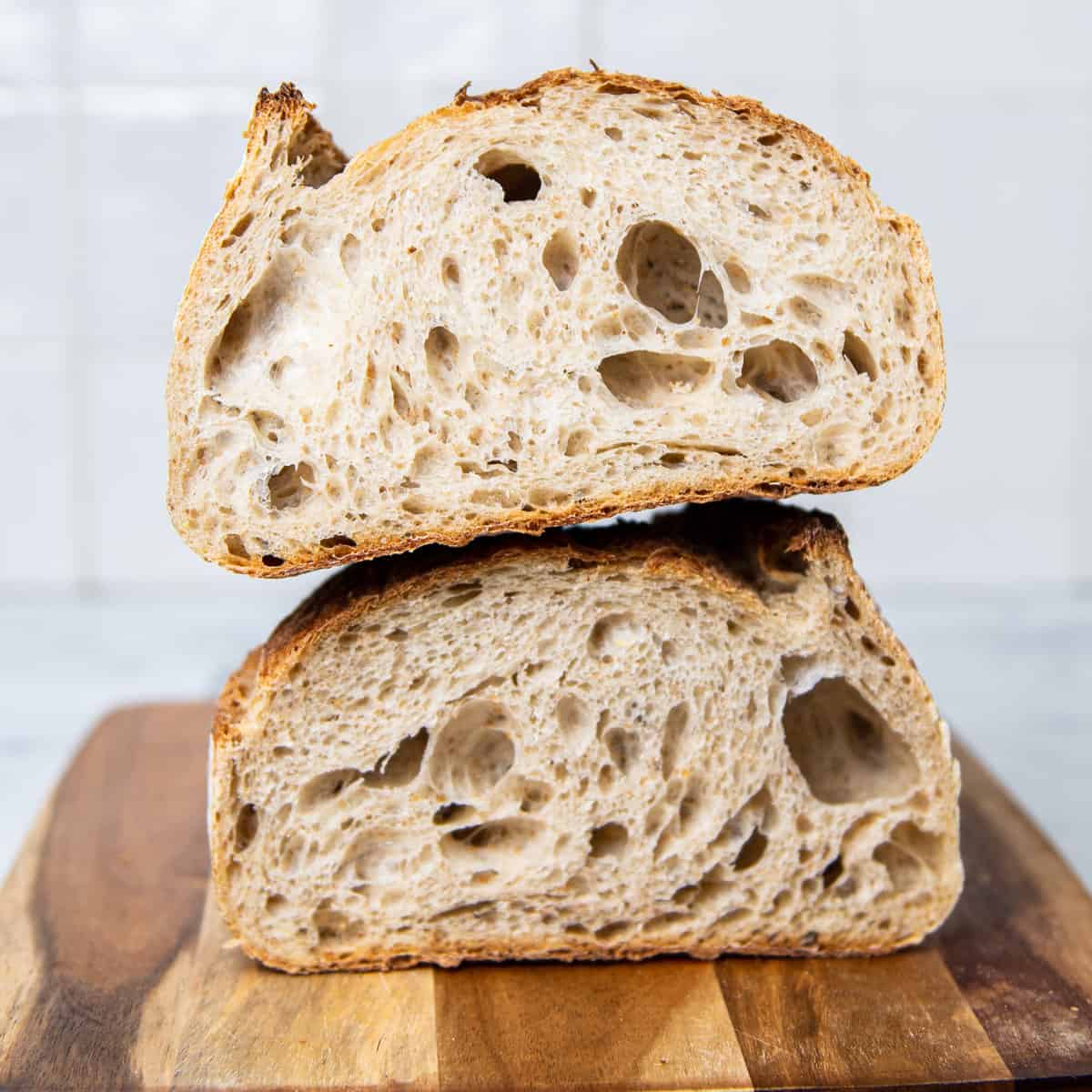Although there are many different types of bread all over the world, sourdough bread is one of the most popular kinds in the West, and you can either buy it or make some yourself. Since bread doesn't always have a long shelf life, it's important to find out how to store sourdough bread so it will fresh for longer.

Jump to:
If your store-bought or homemade sourdough bread has gone a little stale, you can still use it in recipes. Perhaps you don't want a stale sandwich, but you could always use stale bread to make bread pudding or, for a special occasion, eggnog bread pudding.
I love making sourdough bread with its soft inside and perfect crispy crust. One of my favorite ways to make it is with dried fruit and spices, then I like to have a slice warm from the oven with a generous amount of butter spread over it. This type of fresh bread is also great for sandwiches, toast, or similar recipes.
This type of bread is made by fermenting dough with naturally occurring yeast and lactobacilli and the result is a chewy texture and slightly sour taste. It's easier to digest than other types of bread that are made with baker's yeast, which is one reason it's such a popular choice.
What is Sourdough Bread?
To make this kind of bread, you need a sourdough starter, which is a fermented mixture of water and flour that contains bacteria and wild yeast. These microorganisms will naturally leaven the bread, instead of having to use commercial yeast. They also give sourdough bread its signature sour taste and somewhat dense, chewy texture.
So first you have to combine the sourdough starter with flour, salt, and water to form a dough, and then let it rise for a long time, sometimes even days, depending on the recipe you're using. This lets the yeast and bacteria in the sourdough starter feed on the carbs in the dough so it can produce carbon dioxide gas to make the dough rise.
After the dough has risen enough, you can shape it and then bake it at high temperatures, creating a crusty, flavorful loaf with a distinctive texture and taste.
Sourdough bread has an interesting history that goes back centuries. Fermentation predates using commercial yeast which wasn't discovered until the mid-1800s. The first evidence of this type of bread goes back to 3000 AD in ancient Egypt when dough was colonized by wild yeast spores.
Nutrition-wise, sourdough is similar to most other kinds of bread depending on what flour it's made with. It offers fiber, selenium, folate, niacin, thiamine, riboflavin, iron, copper, and manganese.
How to Buy Sourdough Bread
If you prefer to bake your own bread, you will probably have a recipe for it, but how do you determine the best quality sourdough from the store?
Choose a loaf that is soft and has no visible mold. Give it a gentle squeeze and check there is some "give" and it's not hard and dry. Fresh sourdough bread has a pleasant, slightly sweet smell.
Finally, check the expiration date if it's on the package. The loaf might still be fine for a day or so after that but it's best to check the look, feel, and smell of the bread before you purchase it.

How to Store Sourdough Bread
Whether store-bought or homemade, sourdough bread doesn't have an especially long shelf life. It can last longer than other types of bread though because of its natural acidity. The following tips should help you make yours last for longer.
- The best way to keep sourdough bread fresh, whether it's homemade bread or store-bought, is to keep it in a cotton or linen bag, or loosely wrapped in a beeswax wrap because it needs air circulation.
- Keep it in a dry place, such as the pantry or bread bin.
- Don't keep it in plastic wrap or aluminum foil because it will sweat and moisture can encourage bacteria.
- Keep the whole loaf at room temperature, because it dries out too quickly in the refrigerator and will go hard fast.
- The cut side might dry out a little, but you can easily cut it off on a cutting board and discard that piece.
- You can also freeze the entire loaf in plastic wrap and then a freezer bag to prevent freezer burn. When I do this, I cut it into slices first so I only have to thaw the amount I need.
At room temperature, kept in a fabric bag or wrapped in a tea towel, sourdough bread will keep for up to 5 days. If you choose to freeze it, use it within 6 months.
How to Tell if Sourdough Bread is Rotten
Even if you store the bread at room temperature in a cloth bag or linen bread bag, it can still go bad after a couple of days.
So what's an effective way to tell? Well, the most obvious way to tell is if there is visible mold on your loaf of bread or inside of the bread. If not, indicators of spoilage include the loaf being hard and dry, or having a sour, unpleasant smell.
If your bread is a little dried out but not moldy or smelling bad, it should be safe to eat, although you will probably want to toast it or use it to make bread and butter pudding or French toast rather than having it as it is because it will be dry and chewy.
Common Questions
First of all, sourdough is easier to digest than brewer's yeast-based bread, because the wild yeast and lactic acid bacteria produced during fermentation help neutralize antinutrients that grains produce. Gluten, a type of protein in grains can cause gastric issues in those who are allergic to it or sensitive to it.
Sourdough bread does have some gluten content but it's not completely gluten-free because sourdough fermentation doesn't degrade it all. For this reason, those with celiac disease or gluten allergy should avoid it and choose a gluten-free loaf instead.
If you have too much, it's a good idea to slice and freeze the part of the loaf of sourdough bread that you aren't going to use. If you have fresh sourdough bread that's gone slightly dry or hard though, it is possible to soften it again.
Wrap it in a paper towel or linen bread bag and give it 10 seconds in the microwave, or sprinkle some water on top then bake it in the oven for 6 minutes at 325°F.

Interesting Facts
- Cover your home-baked sourdough loaf with a clean dish towel as it cools on the cooling rack, to help lock in the moisture so it doesn't dry out so fast.
- Don't use metal when making sourdough because the bacteria in the starter and the acid cause corrosion, so only use silicon or wooden utensils.
- Master bakers from France introduced their sourdough recipe to Northern California in 1848 and, since 1849, they've been using the same "mother dough" (sourdough culture) to make all their loaves!
When you know how to store sourdough bread you can enjoy this delicious treat over a few days or, if you freeze some, for even longer. There are so many different ways to serve it.














